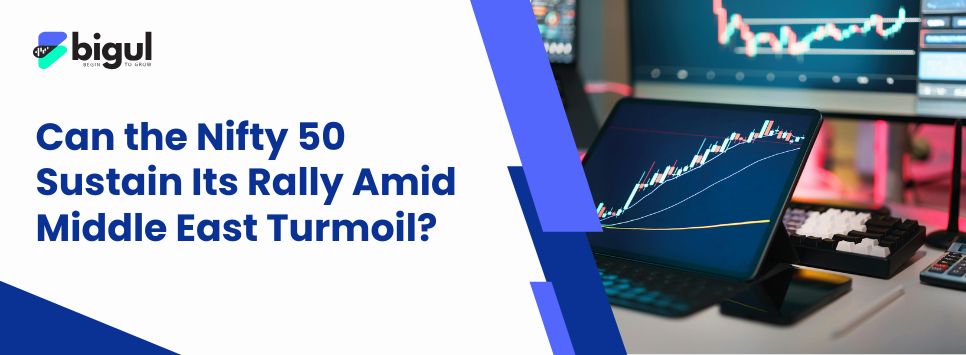Indian markets have been on a remarkable upswing so far in 2025, shrugging off global jitters and charting fresh territory. After a muted start to the year, both the Nifty 50 and BSE Sensex kicked into high gear in late spring. On a few standout days in May and June, the BSE Sensex surged past 82,000 points while the Nifty 50 comfortably cleared the 24,000 mark. Overall, domestic benchmarks are trading within striking distance of their all‑time highs, even as headlines warn of escalating Israel-Iran tensions and the specter of a broader Israel-Iran war.
Recent Market Moves: A Quick Recap
-
Mid‑May breakout: In early May, the Nifty 50 crossed 24,000 for the first time, helped by broad buying across financials and consumer names. The BSE Sensex rallied in tandem, climbing over 2,500 points in under two weeks.
-
Early June peaks: By the second week of June, both indices hit multi‑month highs. The Nifty 50 traded above 25,000, and the BSE Sensex edged past 82,400. These levels had not been seen since late 2024.
-
Volatility around June 18: News of fresh strikes between Israel and Iran briefly rattled global markets. Oil prices spiked back toward $76 per barrel, and emerging‑market currencies dipped. Yet the Nifty 50 and BSE Sensex only slid modestly before rebounding within hours—evidence that the Indian stock market is increasingly viewing such shocks as transient.
How Have Israel‑Iran Tensions Impacted India?
Geopolitical flare‑ups in the Middle East often translate into higher crude prices and risk‑off moves in equity markets. In mid‑June, fresh exchanges of fire between Israel and Iran stoked fears of a wider Israel-Iran war, lifting Brent crude by several dollars and nudging the rupee toward its weakest levels in months.
-
Oil and inflation risks: India imports roughly 85% of its oil. A spike above $75–76 per barrel can pressure retail fuel prices, nudge up inflation, and force the central bank to tread cautiously. Yet, despite the mid‑June jump in crude, India’s consumer‑price gauges remain well anchored compared to many peers.
-
Currency swings: The rupee slid toward 86.2 per dollar when the conflict headlines broke. However, it bounced back once global risk sentiment stabilised, underscoring that traders see the Israel-Iran tensions as a short‑lived event rather than a lasting shock.
-
Equity flows: Foreign investors, who have withdrawn moderately from Indian equities so far in 2025, paused their selling when the June flare‑up hit. Some modest inflows returned within days, suggesting that global funds view India’s growth story as more compelling than fleeting Middle East headlines.
Domestic Fundamentals vs. Global Headwinds
While external risks make for dramatic headlines, the Indian stock market is also powered by solid home‑grown factors:
-
Robust GDP growth: India’s economy expanded at over 7% annualized in the first quarter of calendar 2025, led by rural demand and resilient services activity.
-
Cooling inflation: After a brief uptick on higher oil, core inflation has trended lower, giving the Reserve Bank room to keep real rates supportive.
-
Corporate earnings: Many large companies, especially in financials and technology, reported double‑digit profit gains in Q4 results, bolstering index‑heavy stocks.
Against these positives lie a few caution flags: a still‑high current‑account deficit tied to oil imports, potential US interest‑rate moves, and China’s uneven recovery. Yet, Indian data has regularly surprised to the upside, helping the BSE Sensex maintain its trajectory even when global peers lag.
Has the Indian Stock Market Discounted the Israel‑Iran Flare‑Up?
Given the minimal slide and swift recovery of both the Nifty 50 and BSE Sensex, it appears that most traders have already accounted for the Israel-Iran tensions. In fact:
-
Market reactions have been muted: Intraday swings around June 18 were less than 1% on both indices.
-
Sector leadership has held firm: Banks, autos, and select tech names continued to outperform, while energy stocks—though briefly higher—gave back most gains as oil stabilized.
-
Volatility metrics remain below average: India’s VIX index climbed modestly but stayed well below peaks seen during past crises.
This behavior suggests that Indian investors view the risk of a full‑blown Israel Iran war as low to moderate. Unless the conflict intensifies dramatically or spreads to critical shipping lanes, the consensus seems to be that price risks are contained.
Outlook: Beyond 24,000
If the question is whether the Nifty 50 can revisit 24,000, the answer is that it has already done so with conviction. The more pertinent consideration now is how much higher these indices can go:
-
Short‑term target zone: With strong domestic momentum, the Nifty 50 could test the 26,000–26,500 range in the next few months, provided global rates remain steady.
-
Catalysts to watch: Quarterly earnings, monsoon progress, and any major central‑bank signals from the US or Europe. A sudden spike in crude past $80 could pose a near‑term headwind, but so far, that threshold remains out of reach.
-
Risk buffers: India’s relatively low equity valuation premium versus peers and abundant liquidity in the financial system offer support against moderate shocks.
Meanwhile, the BSE Sensex has room to chase new highs as heavyweight constituents record healthy profits and domestic consumption stays robust. If global markets stabilize around current levels, India’s markets will likely lead the emerging‑market pack in performance.
Conclusion
By mid‑2025, the Indian stock market has largely priced in the Israel-Iran tensions, demonstrating resilience in the face of fresh war fears. Both the Nifty 50 and BSE Sensex weathered the June flare‑up without losing the larger uptrend. The 24,000 milestone for the Nifty 50 is already in the rear‑view mirror, and the focus now shifts to new highs. Absent a sudden escalation into a full‑blown Israel-Iran war, India’s growth fundamentals and solid corporate profits should keep markets on an upward track. While no one can predict every twist in geopolitics, current data suggest that the rally still has room to run, well beyond the 24,000 mark.

.jpg)









.jpg)
.jpg)
